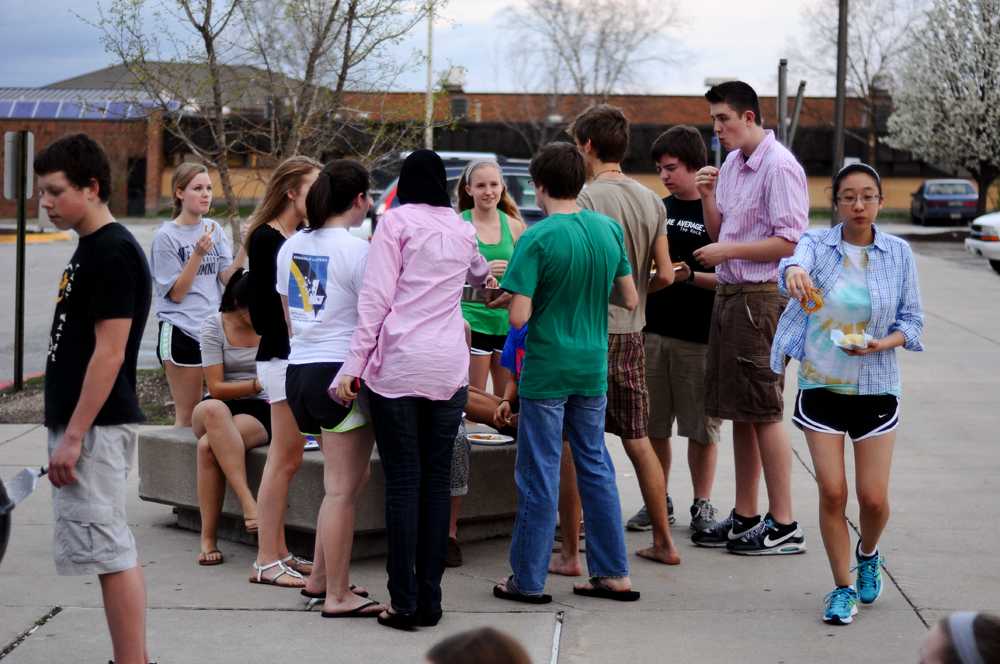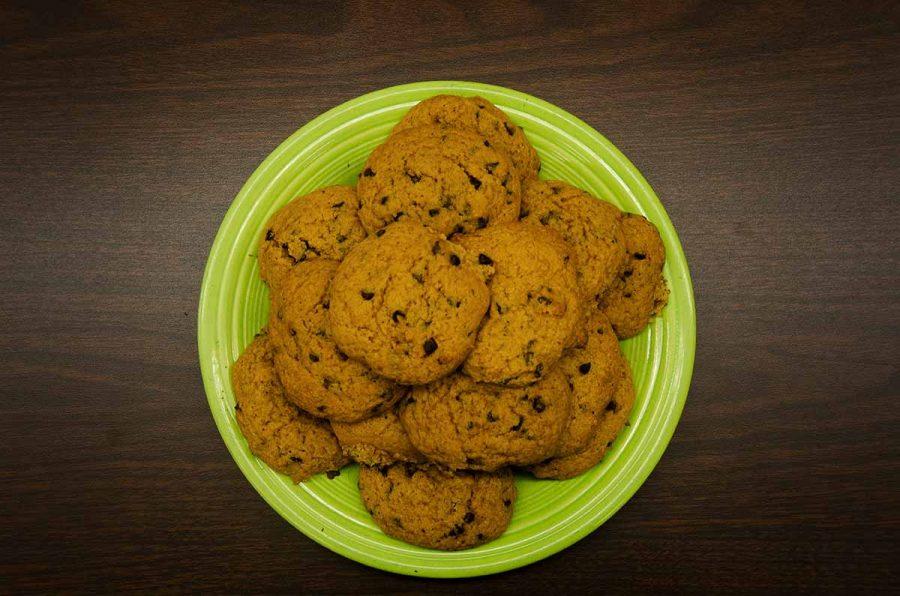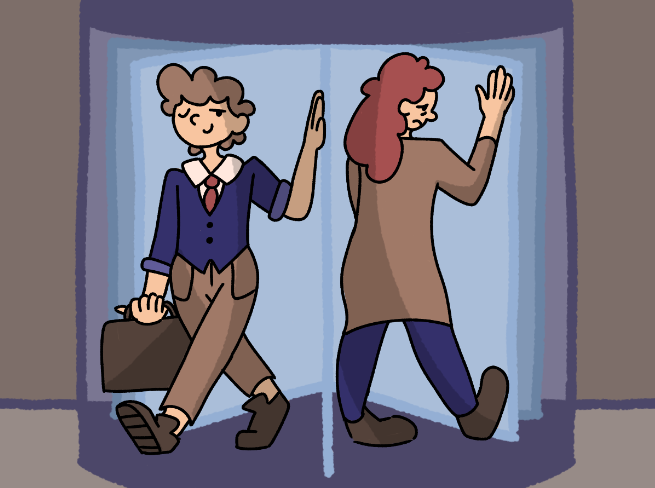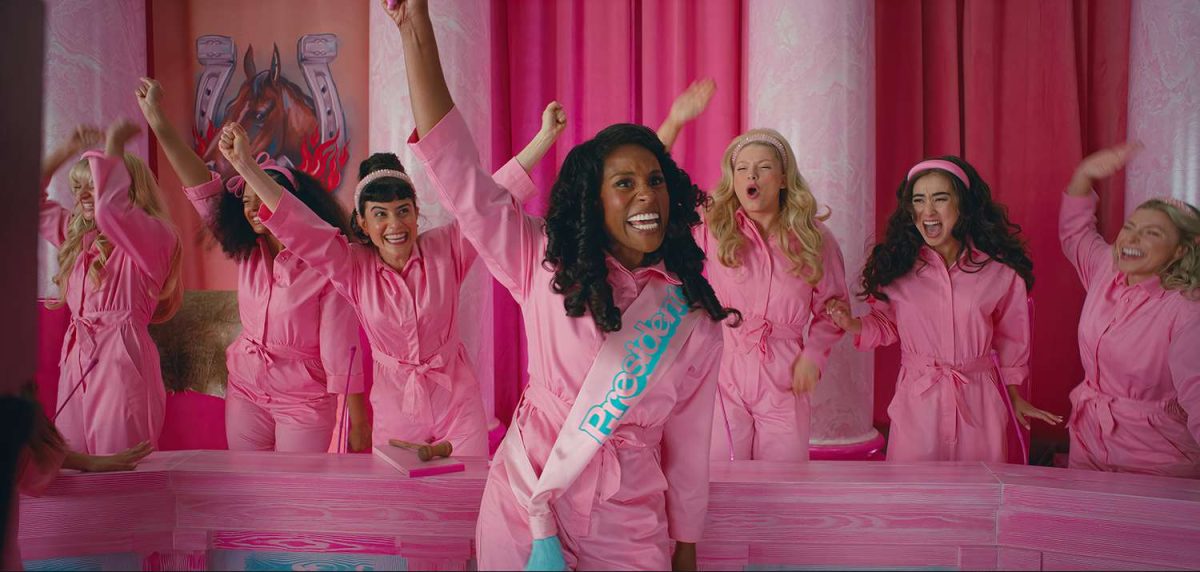
A paper without stories is kind of like a person without organs — it’s thin, flimsy and kind of gross. For that reason, while everyone was still exhausted and bleary-eyed from the late nights — where everybody stays at school until 11 — for the February paper, they had to kick their brains over and come up with six more stories: two for online, four for the paper.
On story idea day itself, the newspaper staff separates into rooms and writes their ideas up on the chalkboard, sorted by section. Everyone with an idea for a feature writes that idea down in the feature section, editorials in the editorial section, news in the news section. The rooms contain categories of stories: in one might be editorials, commentaries and news and in the other might be sports, community, personality profiles and features. Online story ideas are judged in the hall. The editors-in-chief go down the board one idea at a time and whoever came up with it needs to defend it; the idea is then either accepted or vetoed by the section editor.
The split is about 50/50 good ideas and bad ones. This ratio might seem high, but keep in mind that most of the story ideas are hacked together in two days while everyone, including the EICs, are incredibly sleep deprived and don’t have a newspaper class together in which to brainstorm. In addition, a good amount of ideas have already been done, and the rule of the day is if you can remember a similar story, you shouldn’t rewrite that story. The usual turn-around time is about two years.
This story idea day we separated into three groups: the hallway for online stories, the computer lab for a few sections and the main room handling the bulk of the content. This, of course, resulted in the main room taking the entire class to get through one group of people, the room and temperatures both growing hot, while the rest of us, safely hidden in the hallway, played rolly-chair races. Theoretically, this was supposed to save time or something.
Once all the ideas are in place and the writers and section editors have headed off for home, the EICs assign stories.
Interim Day 1It’s funny — time doesn’t really seem to exist in newspaper. First drafts are due in two days, an absurdly short amount of time and yet today is the day when writers get angles. Angles are what story is being told — the wrestling story, for instance, is obviously about wrestling, but the angle could be that of a defending champion or a rising underdog or just a team trying to succeed as best it can.
In any case, angles talks with editors are over pretty quickly, and then writers and editors alike are given freedom to work on their own stories and pages. For instance, Maria K., the community section editor, is behind me laughing at a mustachioed photo of herself being used as a placeholder. Maddie M. is reading a 3000 word report detailing the release of teacher scores in New York, and Avantika K. is desperately trying to recruit someone to write short news stories to go up on the website, which nobody really wants to do. Blake B. is giving away Twizzlers.
I’m sitting here writing this blog instead of working on my robotics story because I’m an oddly misanthropic reporter. It’s funny really, if you ask reporters what their least favorite part of newspaper is they’ll probably respond, “Setting up interviews.” There’s something about the awkward act of planning out a place and time and subject of talking with what is usually a complete stranger. Dare I say if we newspaper kids were a bolder bunch our stories wouldn’t be so late all the time.
In any case, writing stories is different for every writer. There are some, that, like me, are not so good at finding sources and setting up interviews, then there are the opposites who aren’t such big fans of the writing part but love the interviewing process, and then there’s everybody who is good at both.
Well, at least I’m keeping up with this blog instead of writing it on late nights.
First Drafts DaySo we’re up for online Pacemaker. For those, and probably most, who don’t know, the Pacemaker award is the highest in the country for any high school journalism newspaper, website, yearbook and other . Basically, it means in the first five months our website has become one of the top fifteen in the nation. In any case, it means we have the opportunity to go to Seattle for the west coast convention, which is unquestionably awesome. Also, this is the first year the yearbook, newspaper and website have been up for the same award at the same time. So basically, give props to Daphne Yu and Parker Sutherland when you see them in the hall — they’re our online editors.
This was first drafts day, and our (very) rough drafts were due to section editors. A week ago the February paper came out, and already the crushing weight of deadlines sits heavily on pretty much everyone’s shoulders. However, only a small minority of stories are turned in on time for first drafts.
I don’t really know why, but the first draft deadline is easy broken. I know mine won’t be on time. It’s odd (I don’t see the odd part) too because it seems like the end of every month the paper is thrown into a small panic because the stories aren’t done. And yet…
Anyway, with this being a True/False this weekend, a small taskforce is preparing to load the website with information, because, well, T/F is pretty awesome. A ton of people, although theoretically, interested in writing reviews and sight-and-sound pieces recognize that the labor of love that is covering True/False would not bode well for them, as they haven’t finished their first drafts. So it’s down to a small but determined group to cover it all. I’ll admit: I’m not part of it, but that’s mostly because I wrote for Southpaw, our magazine, which was kind of like shooting myself in the foot. But hey, at least here on newspaper, we all shoot our feet together — that is, if one piece of the puzzle doesn’t fit then the entire thing falls apart.
Interim Day 2So today I finally got around to transcribing my interview. For those of you keeping score at home, that means I’m about 5 days behind. I don’t know how this happens. Luckily, I’m in good company because no one turns in stories until they’re about to be cut, and then they do it reluctantly. People on staff wonder why we’re so stressed out all the time, but it’s because they’re the greatest enemy to time management the world has ever known.
The mini-dilemma today was backpage. Backpage is pretty important because it’s visual in nature, so the entire page needs to have a strong and controlling theme. The problem is coming up with said theme. You see, while it would be easy to simply say “Hey, Spring Break!” we won’t because that’s overused. Much like story idea day, the big problem with a backpage is coming up with something unique, or at least a unique take on a subject. For instance, this month we weren’t able to escape the gravitational pull of a spring break backpage, but the subject is staycations, which is at least peripherally unique.
Production WeekDespite seemingly impossible odds against staff writers — that is, quite reasonable ones — most stories are finished well in time to start production. Production week is the last week before the paper comes out, so it’s when things either start to click or go wrong.
Mostly things go wrong at the beginning of the year. To use an incredibly cliche metaphor, this newspaper is like a well oiled machine, albeit one with some serious network latency issues. By March, pretty much everybody has their roles figured out. This year, at least, we haven’t had issues with power struggles or anyone having significant trouble with the machine. Not yet in any case.
In other words, this month production has gone fairly smoothly. Not “leave late nights, two long days before the paper is sent, early” smoothly but it’s a step in the right direction nonetheless. I don’t have a page per se; I’m just monkeying around trying to finish up various online stories. However, pages have begun to move, which means they are being edited for accuracy, not just general design, and stories and art are being placed on them. In other words, stuff just got real.
I Lost TrackTwas the class before late nights, and all through the house, all the creatures were stirring because they wanted to get a few x’s on the chart before crunchtime. Yes, it’s that wonderful time of the month that really defines newspaper: late nights. Two nights, every month, where everyone on staff stays at school until eleven to make or break the paper. Yeah, it’s awesome.
Since at long last my own article is finished and up on the server to be placed onto a page, I thought it would be appropriate to give a sense of scale to the paper, mostly because I don’t really want to work on my page. The paper, I think it is fair to say, is a pretty big undertaking, especially every month, but it’s actually kind of hard to delineate exactly how much work goes in.
It starts with the writers. Every writer — about 40 all told — writes at least two articles every month. Many write more. In any case, each of those writers turns in their first drafts to the section editors. Section editors edit those stories, and give them back. Each section editor edits about seven stories a month. So imagine if you had to peer-edit seven papers in the space of about two days in addition to writing and turning in two of your own. And they have to be edited well, as they’re for publication.
After first drafts, naturally, comes seconds. Most stories don’t make it to first drafts on time because of what I deem “too-much-time syndrome,” but they’re cut from the paper if they don’t make it to seconds in time. But since that’s an a 150 point hit to grades, most make it on time(ish). Second drafts are edited by EICs. There are three of them. So, while trying to keep up with their regular course loads and finish their own articles, EICs must edit somewhere from 15 to 20 stories. Every month. Sleep is a luxury.
After that comes third drafts, edited by the journalism teacher Robin Stover, who edits EVERY story, some more then once. And once all the stories are done and the pages are (hopefully) mostly designed comes…
Late NightsThe Rock
Late nights are unique. They are what make
what it is. It’s a bonding experience for the staff and works well to make everyone gel. It’s also the time when the paper is pieced together. Stories and art are hurriedly finished, surveys are done, and photos are taken.
Every page in the paper, from in-depths to ads to backpage, goes through 11 edits. The staff splits up, assigning a writer, sometimes two, per page, and pretty much everyone is working straight until 11 at night, at least on Mondays. At the end of late nights, pretty much everyone is either smiling or pulling out his hair. Preferably not the latter.
They follow a familiar pattern. After school, the staff slowly trickles into the lab and works more or less hard for about three hours. Then comes dinner.
Dinner is prepared by usually two or more staff members. This time, it was me and Thomas Jamison-Lucy furiously out-grilling a tremendous rainstorm outside the north entrance. Photographer Asa Lory prepared homemade onion rings to add on a the perfect touch.
After dinner came a thirty-man game of ninja, naturally. The rain arrived about three hours late.
After dinner comes a scramble as everyone realized the enormous amount of work they could have been doing while they were eating dinner. This is definitely the most heated portion of late nights, where the worst problems arise, that sweet spot between seven and 10 where people work like the dickens to get the paper out. This is when around 50% of all work that gets done in newspaper is done. That may have been some light exaggeration.
After all, at late nights all we can hope for is that the art is done and the stories are written, and the rest just comes with time. The problem is that when one of these elements is missing, newspaper turns into a game of “everyone bother one person until he grows too frustrated to work.” Luckily, this rarely happens, because usually everyone is enjoying the downtime they get from their page frozen in time and space.
Ah, downtime! That magical time when friendships are forged, games are played and people commandeered to write online articles! I can’t speak for everyone, but I know downtime is one of my favorite parts of late nights, opposite getting awesome authentic meals from various folk. It’s being free to move about the cabin, which is not that unusual at RBHS; we have this thing AUT, you see, that kind of functions in a similar manner. But there is a certain magic to being at school “waaaaay” after everyone else (I know: nerd alert) and the simple pleasure of not doing anything with several other people after working for hours and hours and hours that make downtime like sinking into a silk mattress with down pillows, et cetera, after working all day in the most classically hard of pastimes: ditch digging.
The second late night goes pretty similarly to the first: if the first was easy, the second might finish early. If the first was hard, well, then there’s always next month to have fun. Not that working isn’t fun, but the stress that comes from having almost nothing on the chart for the first late night, especially for our beloved EICs, can be a lot to bear and usually means some heated tempers. After all, it’s important to assign blame.
The last bit of late nights is composed of last looks. This is why I’m usually genuinely surprised when a typo makes it into the print edition. After some eleven edits, you’d think that spell check + three to seven people reading every article on the page one last time would catch them all. And yet, somehow, those dastardly marks slip through.
The RockBut I digress. Last looks are super relaxing. It’s the end of the night, lights are off, and everyone’s in their favorite chair reading
and scanning for typos and grammar mistakes. It has that nice sort of silence that a library has, that is broken every once and a while by a funny comment or a correction, and everyone’s so tired by that point that laughs come easily. Imagine a movie night where everyone read a paper together and looked for spelling mistakes.
Folding DayThe last bit of paper is Folding Day. We don’t have enough money to both print our paper in color and have it folded for us, so every Thursday when the papers are delivered, everyone (read: like half the staff, though everyone SHOULD be there) comes into journalism around 7 to fold all 1500 papers. Oh yeah, it’s fun.
three full days in a rowOther then the whole mandatory teenage disdain for manual labor thing, my only problem with folding day is that it always seems to magically align with my first hour AUT. This means that often when the paper comes out I have to be at school on time for
. I find this unacceptable.
But, it’s nice to see the fruit of our labor. Literally, hundreds of hours of labor goes into every single issue. And then we hand them out, distribute them, and pretend that people read them. And another paper toddles away, all grown up.
And then, next class period is story idea day, and the cycle begins anew…
By Adam Schoelz















































































Maddie • Apr 18, 2012 at 9:58 pm
You captured newspaper perfectly! Great job and a fun read!!
Kirsten • Apr 13, 2012 at 4:52 pm
hahahaha! good writing adam!!!
Joanne Lee • Apr 13, 2012 at 4:25 pm
Haha, I love this. Simply love it.